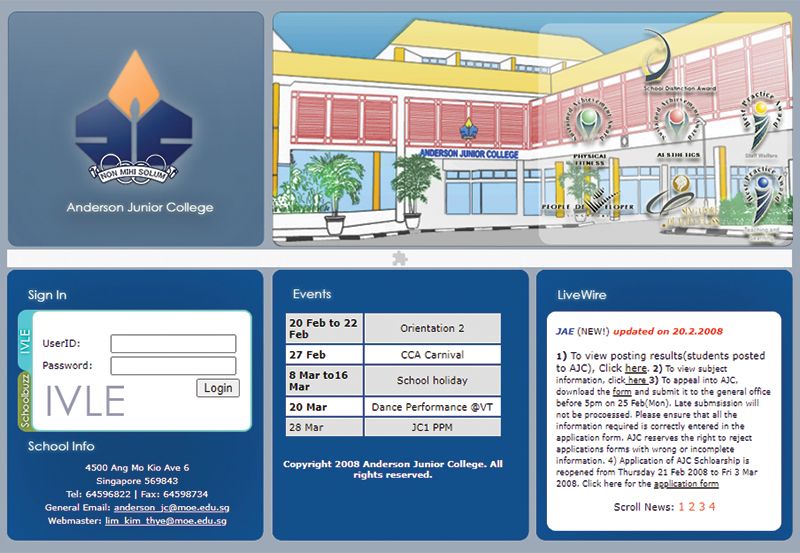An Archive of Singapore Websites: Preserving the Digital
The National Library’s effort to archive Singapore-related websites creates a snapshot of the present that is valuable to both scholars and nostalgia buffs, says Shereen Tay.

As an adult, passing by one’s old school usually brings back strong memories. School is where we made lifelong friends, where caring teachers inspired us and where shared experiences in the classroom and on the playing field brought everyone closer together. It is not surprising then that people are very sentimental about their old schools.
In Singapore, however, few things stand still. Sometimes, schools move to new, improved premises in a different location – to the dismay of alumni who are attached to the familiar old buildings. Some schools, on the other hand, have had to merge with others because of falling birth rates and the changing demographic profile of housing estates.
However, if you are an old boy or girl of now-defunct Anderson Junior College, Balestier Hill Primary School, First Toa Payoh Secondary School, Loyang Primary School or Telok Kurau Secondary School, not all is lost. You can still explore your alma mater’s digital footprint on the National Library’s Web Archive (WAS) portal. Currently, the portal has the websites of 43 defunct schools in its archive, which can be found on eresources.nlb.gov.sg/webarchives.
These websites offer a peek into the 30,000-strong collection on the WAS portal. The National Library collects and archives Singapore-related websites because preserving the country’s documentary heritage is part of its mission, and these days, documents are as much digital as they are pieces of paper.
To help people find information, the WAS portal employs full-text search capability that allows search by keyword or URL. In addition to this, the National Library has also organised some of these websites into themes that may be of interest to researchers or the public at large. These are found in the Special Collection section of the portal. Besides defunct schools, you can view past events like the 2015 Southeast Asian Games and ASEAN Para Games, the 2018 Trump-Kim Summit, National Day parades and even the Singapore Budget.
The National Library is constantly on the lookout for new collections to add to the portal. The most recent addition has to do with the COVID-19 pandemic in Singapore. The library has been documenting the impact of the pandemic here since January 2020 when the government set up the COVID-19 task force. Today, the portal is a trove of archived pages and websites containing news, commentaries and stories pertaining to the pandemic.1 These include the websites of the Ministry of Health as well as news providers such as Mothership.
Collecting Today for Tomorrow
The National Library began collecting websites in 2006. In the early years, one obstacle was that the library needed the written consent of website owners, which slowed down the archival process considerably. A further problem was that only a small percentage of website owners gave the green light to go ahead with the archiving.
In order to create a more comprehensive database of websites, the National Library Board Act was amended in 2019 to allow the library to archive websites without the consent of their owners. This move was in line with similar measures adopted in countries such as the United Kingdom, Australia, New Zealand, Japan and South Korea, among others. Globally, there is growing recognition that websites – as important records of a country’s knowledge, history and memory – must be systematically archived and preserved for future generations.
Since then, the pace of web archiving in Singapore has picked up significantly, aided by a Memorandum of Understanding inked between the National Library and the national registry of .sg websites, Singapore Network Information Centre (SGNIC). Under this agreement, SGNIC sends the library a yearly list of registered .sg websites. There are currently more than 180,000 websites using the .sg domain.
To date, the library has conducted two annual exercises to archive .sg websites. These include websites of associations, businesses and cultural institutions that reflect various aspects of Singaporean life, culture and heritage.
Apart from this, the library also selects websites with substantial heritage value to be archived quarterly. These include government websites, those belonging to arts groups such as the Singapore Dance Theatre, websites on heritage and culture such as the Singapore Heritage Society, and informational websites on current affairs such as Rice Media, and lifestyle and interest groups such as ZeroWasteSG.
Websites on topics of national and social interests are also regularly selected by librarians so that the information can be preserved before the websites are taken down or their content is changed. Examples include websites for the National Day Parade, the 2020 General Election, the Chingay Parade, the Singapore Writers Festival as well as websites detailing policies that affect the general population, and trending events that have generated substantial media coverage.
For copyright reasons, a majority of these websites can only be viewed from a designated computer terminal on level 11 of the Lee Kong Chian Reference Library at the National Library Building. Archived websites that are freely accessible over the internet on WAS include government websites and websites whose owners have given permission to do so. The library will progressively seek permission from more owners so that the information on the portal can be more easily accessible.
From Websites to Social Media
To supplement its digital collection efforts, the library is now looking at preserving Singapore-related content on popular social media platforms like Facebook, Twitter and Instagram. However, collecting social media posts is not a straightforward matter. Besides the technical difficulties, there are also legal, copyright and privacy concerns.
The National Library is not alone in facing these challenges however, as many major cultural institutions abroad are also grappling with similar issues. The National Library has been communicating with its overseas counterparts to learn from their experience in collecting social media posts that is both respectful and within the confines of the law. The library is now conducting a feasibility study and learning from the experience of its counterpart in New Zealand.2
But ahead of this, the library has already begun archiving selective Twitter hashtags related to the COVID-19 pandemic in Singapore, such as #SGUnited, #CircuitBreaker and #StayHomeForSG.
By preserving websites and social media posts related to Singapore, the National Library is building a rich repository of primary materials that reflects life in the country today. In future, scholars and interested citizens will be able to turn to this invaluable resource to discover what Singapore used to look like in the early 21st century.
 Anderson Junior College
Anderson Junior College
(Archived on 4 April 2008)
Anderson Junior College (AJC) was one of the eight junior colleges that merged in 2019 due to declining intakes. The school combined with Serangoon Junior College to form Anderson Serangoon Junior College. The WAS portal has archived several iterations of AJC’s website over the years. The earliest was archived in 2006.
 Nature Society (Singapore)
Nature Society (Singapore)
(Archived in March 2019)
The Nature Society is a non-governmental organisation advocating nature conservation in Singapore. Its website contains important information about the society – such as news, publications and reports, projects and activities of its special-interest groups – that is not easily available from other sources.
 Shereen Tay is an Associate Librarian with the National Library, Singapore. She is part of the team that oversees the statutory functions of the National Library Board, particularly web archiving.
Shereen Tay is an Associate Librarian with the National Library, Singapore. She is part of the team that oversees the statutory functions of the National Library Board, particularly web archiving.
NOTES
-
Access the special collection on the COVID-19 pandemic in Singapore at https://eresources.nlb.gov.sg/webarchives/special-collection/detail/10252. ↩
-
National Library of New Zealand. (2019). Is your Facebook account an archive of the future? Retrieved from the National Library of New Zealand website. ↩

